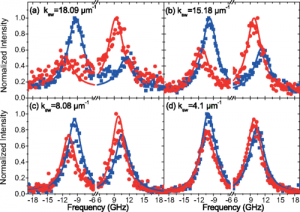Reference: M. Belmeguenai et al., Phys. Rev. B 91, 180405(R) (2015).
Our recent study on the strength of the Dzyaloshinskii-Moriya interaction in ultrathin Pt/Co/AlOx films has just appeared in Physical Review B.
Following our earlier work on characterizing domain wall profiles using NV-centre magnetometry, we probed the strength of the interface Dzyaloshinskii-Moriya interaction in Pt/Co/AlOx films by examining the spin wave spectra with Brillouin light spectroscopy. This work was conducted in collaboration with colleagues at the LSPM, Univ. Paris 13 in Villetaneuse.
The Dzyaloshinskii-Moriya interaction leads to nonreciprocal propagation of spin waves, i.e., for a given wave vector, spin waves propagation to the left do not have the same frequency as spin waves propagating to the right. By measuring how light scatters from such spin waves, namely how the frequency of the reflected photons change at different angles of incidence, it is possible to determine the magnitude of this nonreciprocity, which in turns allows the strength of the Dzyaloshinskii-Moriya interaction to be quantified. We studied such frequency shifts for different thicknesses of the ferromagnetic cobalt layer and found a behavior that is consistent with a single value of the interfacial Dzyaloshinskii-Moriya interaction, with a strength of -1.7 pJ/m. This interaction favours left-handed chiral spin textures and might be large enough to support skyrmions in this material at room temperature.
